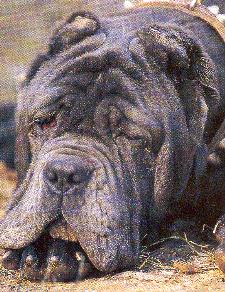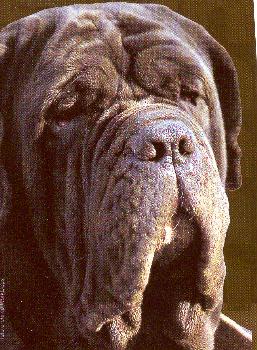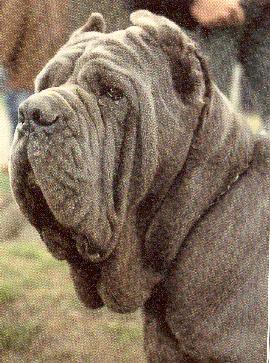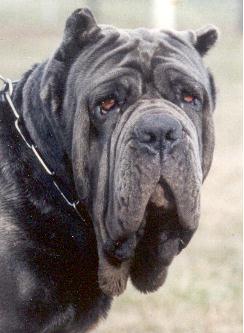



OVERVIEW
THE
ESSENCE OF THE MASTINO
STANDARD
JUDGING
MORE
INFO
HISTORY
THE STANDARD: Expression and Eyes
The Standard Says:
Expression: Wistful at rest. Intimidating when alert. Penetrating stare. Eyes: set deep and almost hidden beneath drooping upper lids. Lower lids droop to reveal the haw. Color: Shades of amber or brown, in accordance with coat color. Pigmentation of the eye rims same as the coat color.
Severe faults: Whitish-blue eyes; incomplete pigmentation of the eye rims
Commentary
The eyes are deep-set and hidden. You've heard the expression "the eyes are the window to the soul." Well, in its job as guard, when the mastino is looking at you, you usually cannot see the eyes, and you cannot tell what it is thinking. You may not even know if it is truly looking at you by looking at the eyes. However, when a Mastino is alert and is paying attention to you (because you did something that caught its attention and it is trying to determine if there is something it should be concerned about) its entire aspect is intimidating simply by the intensity of the expression of the face. The wrinkles and folds all contribute to this.
|
|
|
|
|
|
When the mastino is not looking at you, or when it is not especially alert (typical for this breed, especially when in the show ring...more about this under the discussion of temperament) it simply gazes around bored.
The lower lids of the eye droop to reveal the haw. This is one of many aspects of the breed that is at variance with the "normal" breeds. In most breeds you want a nice tight eye. And most judges will not be used to seeing that red haw, and may instinctively want to "mark down" a dog which exhibits this.
This is because you've probably learned or been taught that when these breeds are doing their job, out in the field hunting or sporting, or "going to ground" to chase vermin, or running in the woods or forest or heather or gorse, a nice tight eye rim protects the eye so chaff doesn't get in there.
Well, the Neapolitan Mastiff isn't doing any of this. Additionally, it is bred to have loose skin which translates to loose eye-rims. Yes, in the course of a day, a bit of chaff may get in the eye. Interestingly enough, though, the looseness of the skin actually helps get rid of most of this, as the skin is so loose as it moves across the eye, any chaff drops out, instead of getting caught in the skin.
Eye Color: The standard says shades of amber or brown in accordance with coat color. In essence, the darker the better. This is because, you remember, the eyes are typically hidden, and a light eye in a dark dog will be more easily seen. The coat colors are Black, Blue (Grey), Mahogany (a Reddish-brown) and Tawny (a pinkish-yellow). The Blue dogs can range from a very light almost silvery-blue, to a very dark, almost gun-metal dark. The darker colored dogs should have a darker eye. The lighter colored dogs, the lighter Blue's and the Tawny's, can tolerate a lighter colored eye, some a pretty light-ish yellowish color.
SERIOUS FAULT: Whitish-blue eyes, incomplete pigmentation of the eye rims.
The mastino puppy is born with a very bright sky-blue eye. It typically changes within three months or so, but occasionally can take six months to change. A dog of a year of age or more must not have a light blue eye. It is a serious fault for a dog to have a light blue eye. A light blue eye makes the eye more visible, no matter what color the dog. Same thing with eye-rim pigmentation. It changes the expression of the dog from a penetrating stare which makes the on-looker stop in wonder and worry. The expression of a dog with a visibly light-blue eye is more wolf-like. And the Neapolitan Mastiff never looks like a wolf.
Note: What do you do if the dog you have picked out as the best one with the best Wrinkle, best Head, and best Mass, and it generates the right Emotional impact, and it has the right construction..and then upon close-up examination you discover that the dog has whitish-blue eye color? Well, we really can't tell a judge to pick a dog with a serious fault. However....if the eye color isn't visible when looking at the dog normally, and if this is truly the best one, by far, there really is no good second best, a judge may be forced to go ahead and award the dog despite the serious fault.
However, if the color of the eye is visible by everyone when just looking at the dog, the eye is visible, or the incomplete pigmentation is clearly visible from anyone looking at the dog at a distance, it is far more difficult to make that recommendation. To the breeder, to the breed fan, it is just a plain ugly eye. It changes the expression and isn't correct. (fortunately, the problem of incomplete pigmentation is pretty rare, as is the light-ish colored eye.
Click NEXT to see the "Ears, Skull, Stop, Nose" topic ![]()
Click PREV to return to the "Head" topic ![]()
(c) 2001 United States Neapolitan Mastiff Club All rights Reserved